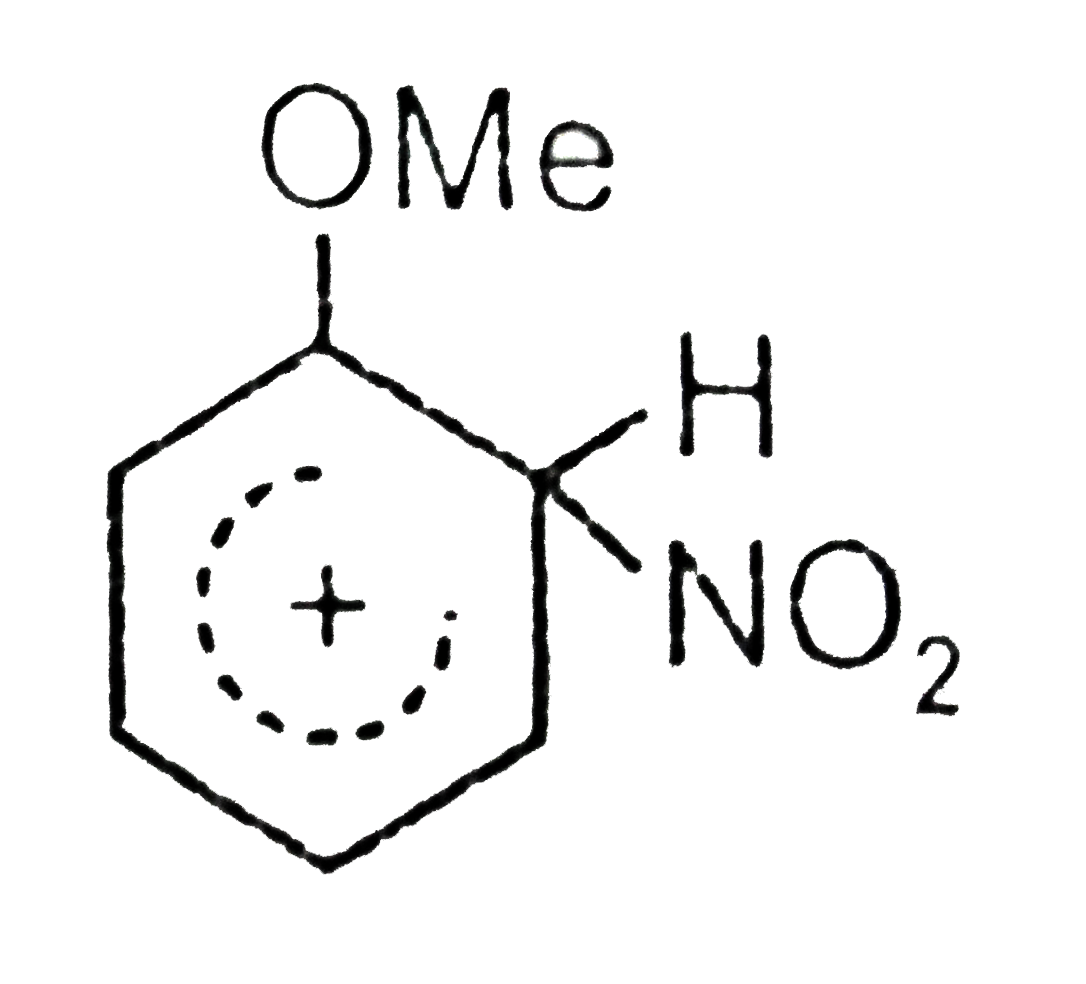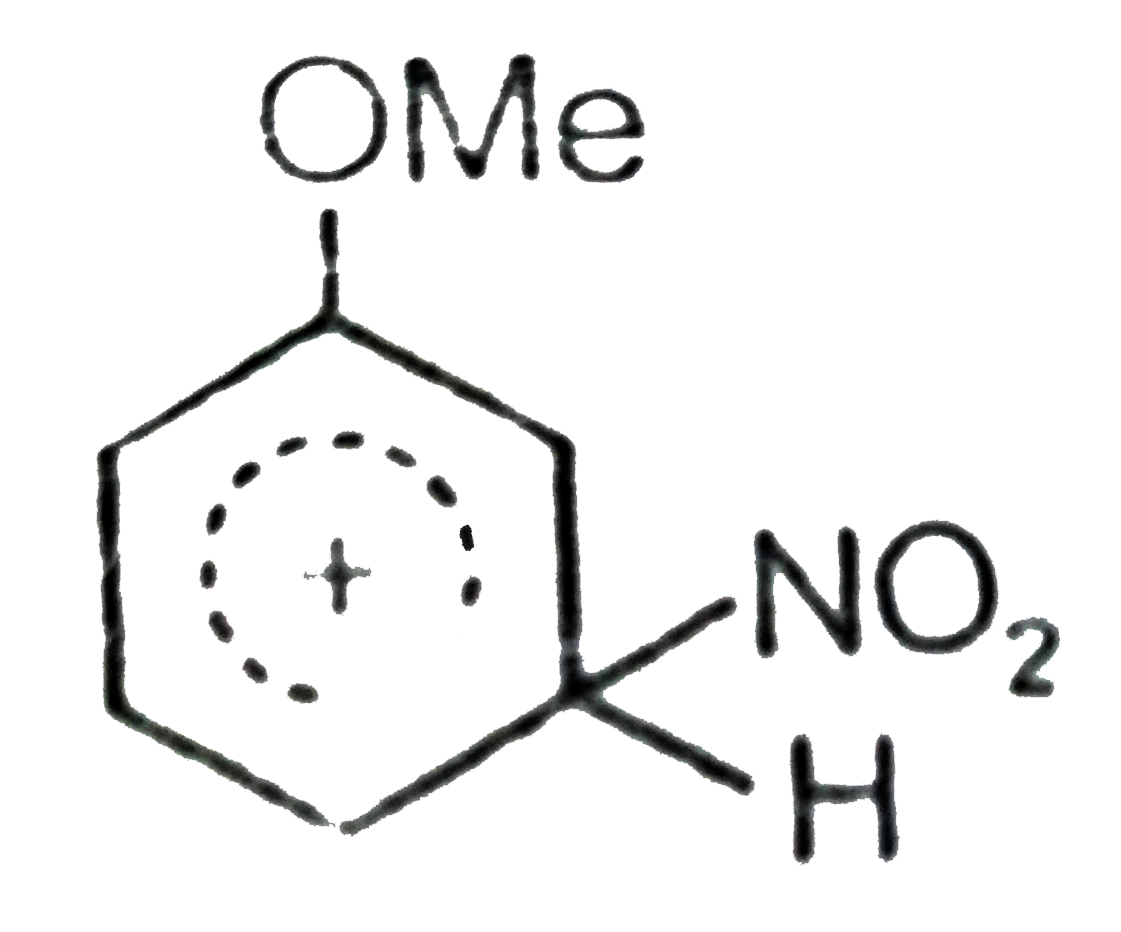Structures of σ-complex formed during nitration of Anisole would be
(a) 
(b) 
(c) 
(d) 
The correct Answer is:A, C
To determine the structures of the sigma complex formed during the nitration of anisole (methoxybenzene), we need to follow a systematic approach. Here’s a step-by-step solution:
Step 1: Identify Anisole and the Nitration Conditions
Anisole is methoxybenzene, which has the structure C6H5OCH3. The nitration is typically carried out using a nitrating mixture of concentrated nitric acid (HNO₃) and concentrated sulfuric acid (H₂SO₄). This mixture generates the nitronium ion (NO+2), which acts as the electrophile.
Hint: Remember that the methoxy group is an electron-donating group, which influences the reactivity of the benzene ring.
Step 2: Understand the Electrophilic Attack
The methoxy group (OCH3) is an activating group and directs electrophilic substitution to the ortho and para positions due to increased electron density at these sites.
Hint: Identify the ortho and para positions relative to the methoxy group on the benzene ring.
Step 3: Form the Sigma Complex at the Ortho Position
When the nitronium ion attacks the ortho position, the following structure is formed:
1. The NO+2 ion attacks the ortho carbon.
2. A sigma complex is formed where the positive charge is located on the carbon atom that was originally bonded to a hydrogen atom.
3. The positive charge can be stabilized by resonance with the adjacent pi electrons.
The structure can be represented as:
- C6H4(NO2)(OCH3) with a positive charge on the ortho carbon.
Hint: Draw the resonance structures to visualize how the positive charge can be delocalized.
Step 4: Form the Sigma Complex at the Para Position
Next, consider the attack at the para position:
1. The NO+2 ion attacks the para carbon.
2. A sigma complex is formed with the positive charge on the para carbon.
3. Similar to the ortho complex, this positive charge can also be stabilized by resonance.
The structure can be represented as:
- C6H4(NO2)(OCH3) with a positive charge on the para carbon.
Hint: Again, draw the resonance structures to see how the positive charge can be delocalized.
Step 5: Summarize the Sigma Complex Structures
The two sigma complexes formed during the nitration of anisole are:
1. Ortho sigma complex: Positive charge on the ortho carbon.
2. Para sigma complex: Positive charge on the para carbon.
Final Answer
The structures of the sigma complexes formed during the nitration of anisole are:
- Ortho sigma complex: C6H4(NO2)(OCH3) with a positive charge at the ortho position.
- Para sigma complex: C6H4(NO2)(OCH3) with a positive charge at the para position.
Anisole is methoxybenzene, which has the structure C6H5OCH3. The nitration is typically carried out using a nitrating mixture of concentrated nitric acid (HNO₃) and concentrated sulfuric acid (H₂SO₄). This mixture generates the nitronium ion (NO+2), which acts as the electrophile.
The methoxy group (OCH3) is an activating group and directs electrophilic substitution to the ortho and para positions due to increased electron density at these sites.
When the nitronium ion attacks the ortho position, the following structure is formed:
2. A sigma complex is formed where the positive charge is located on the carbon atom that was originally bonded to a hydrogen atom.
3. The positive charge can be stabilized by resonance with the adjacent pi electrons.
- C6H4(NO2)(OCH3) with a positive charge on the ortho carbon.
Next, consider the attack at the para position:
2. A sigma complex is formed with the positive charge on the para carbon.
3. Similar to the ortho complex, this positive charge can also be stabilized by resonance.
- C6H4(NO2)(OCH3) with a positive charge on the para carbon.
The two sigma complexes formed during the nitration of anisole are:
1. Ortho sigma complex: Positive charge on the ortho carbon.
2. Para sigma complex: Positive charge on the para carbon.
The structures of the sigma complexes formed during the nitration of anisole are:
- Ortho sigma complex: C6H4(NO2)(OCH3) with a positive charge at the ortho position.
- Para sigma complex: C6H4(NO2)(OCH3) with a positive charge at the para position.
Topper's Solved these Questions
- HYDROCARBONSBOOK - AAKASH INSTITUTE ENGLISHCHAPTER - HYDROCARBONSEXERCISE - SECTION-D LINKED COMPREHENSION TYPE QUESTIONS
7 Videos
- HYDROCARBONSBOOK - AAKASH INSTITUTE ENGLISHCHAPTER - HYDROCARBONSEXERCISE - SECTION-E ASSERTION-REASON TYPE QUESTIONS:
9 Videos
- HYDROCARBONSBOOK - AAKASH INSTITUTE ENGLISHCHAPTER - HYDROCARBONSEXERCISE - SECTION-B OBJECTIVE TYPE QUESTIONS (ONE OPTION IS CORRECT)
25 Videos
- HALOALKANES AND HALOARENES BOOK - AAKASH INSTITUTE ENGLISHCHAPTER - HALOALKANES AND HALOARENES EXERCISE - ASSIGNMENT SECTION -D
15 Videos
- HYDROGENBOOK - AAKASH INSTITUTE ENGLISHCHAPTER - HYDROGENEXERCISE - ASSIGNMENT (SECTION - D) (Assertion-Reason Type question)
15 Videos
Similar Questions
Synaptonemal complex is formed during
View SolutionComplex structure formed during synapsis is called
View SolutionTransition state structure of the substrate formed during an enzymatic reaction is
View SolutionTransition state structure of the substrate formed during an enzymatic reaction is
View SolutionHardness of water is estimated by simple complex formation titration Complex formed by cation in hard water during estimation of hardness is .
View SolutionComplex(s) fotmed during the hydrometallurgy of Ag ore is/are
View SolutionPygostyle is complex formed by fusion of
View SolutionA sigma bond is formed by the overlapping of
View SolutionComplexes formed in the cyanide process are:
View SolutionCan a σ bond be formed in the absence of π bond ?
View Solution
